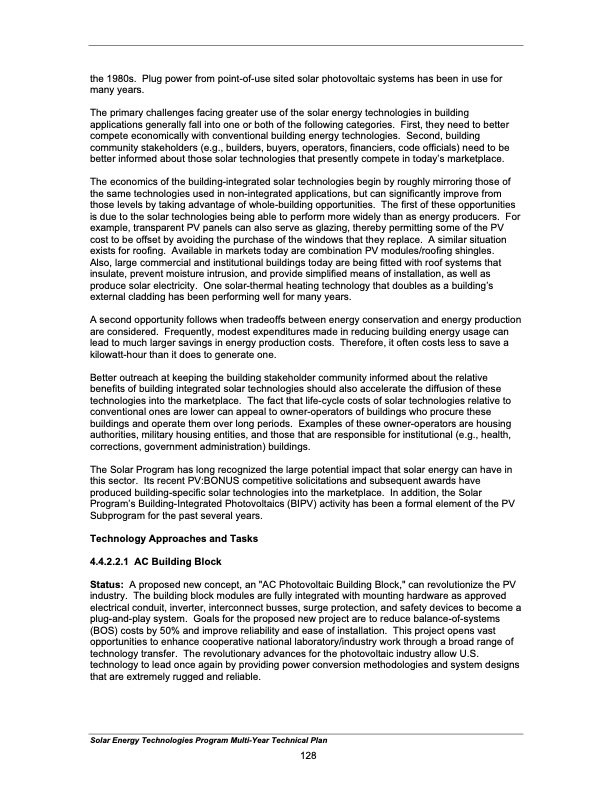
PDF Publication Title:
Text from PDF Page: 137
the 1980s. Plug power from point-of-use sited solar photovoltaic systems has been in use for many years. The primary challenges facing greater use of the solar energy technologies in building applications generally fall into one or both of the following categories. First, they need to better compete economically with conventional building energy technologies. Second, building community stakeholders (e.g., builders, buyers, operators, financiers, code officials) need to be better informed about those solar technologies that presently compete in today’s marketplace. The economics of the building-integrated solar technologies begin by roughly mirroring those of the same technologies used in non-integrated applications, but can significantly improve from those levels by taking advantage of whole-building opportunities. The first of these opportunities is due to the solar technologies being able to perform more widely than as energy producers. For example, transparent PV panels can also serve as glazing, thereby permitting some of the PV cost to be offset by avoiding the purchase of the windows that they replace. A similar situation exists for roofing. Available in markets today are combination PV modules/roofing shingles. Also, large commercial and institutional buildings today are being fitted with roof systems that insulate, prevent moisture intrusion, and provide simplified means of installation, as well as produce solar electricity. One solar-thermal heating technology that doubles as a building’s external cladding has been performing well for many years. A second opportunity follows when tradeoffs between energy conservation and energy production are considered. Frequently, modest expenditures made in reducing building energy usage can lead to much larger savings in energy production costs. Therefore, it often costs less to save a kilowatt-hour than it does to generate one. Better outreach at keeping the building stakeholder community informed about the relative benefits of building integrated solar technologies should also accelerate the diffusion of these technologies into the marketplace. The fact that life-cycle costs of solar technologies relative to conventional ones are lower can appeal to owner-operators of buildings who procure these buildings and operate them over long periods. Examples of these owner-operators are housing authorities, military housing entities, and those that are responsible for institutional (e.g., health, corrections, government administration) buildings. The Solar Program has long recognized the large potential impact that solar energy can have in this sector. Its recent PV:BONUS competitive solicitations and subsequent awards have produced building-specific solar technologies into the marketplace. In addition, the Solar Program’s Building-Integrated Photovoltaics (BIPV) activity has been a formal element of the PV Subprogram for the past several years. Technology Approaches and Tasks 4.4.2.2.1 AC Building Block Status: A proposed new concept, an "AC Photovoltaic Building Block," can revolutionize the PV industry. The building block modules are fully integrated with mounting hardware as approved electrical conduit, inverter, interconnect busses, surge protection, and safety devices to become a plug-and-play system. Goals for the proposed new project are to reduce balance-of-systems (BOS) costs by 50% and improve reliability and ease of installation. This project opens vast opportunities to enhance cooperative national laboratory/industry work through a broad range of technology transfer. The revolutionary advances for the photovoltaic industry allow U.S. technology to lead once again by providing power conversion methodologies and system designs that are extremely rugged and reliable. Solar Energy Technologies Program Multi-Year Technical Plan 128PDF Image | Solar Energy Technologies Program

PDF Search Title:
Solar Energy Technologies ProgramOriginal File Name Searched:
33875.pdfDIY PDF Search: Google It | Yahoo | Bing
NFT (Non Fungible Token): Buy our tech, design, development or system NFT and become part of our tech NFT network... More Info
IT XR Project Redstone NFT Available for Sale: NFT for high tech turbine design with one part 3D printed counter-rotating energy turbine. Be part of the future with this NFT. Can be bought and sold but only one design NFT exists. Royalties go to the developer (Infinity) to keep enhancing design and applications... More Info
Infinity Turbine IT XR Project Redstone Design: NFT for sale... NFT for high tech turbine design with one part 3D printed counter-rotating energy turbine. Includes all rights to this turbine design, including license for Fluid Handling Block I and II for the turbine assembly and housing. The NFT includes the blueprints (cad/cam), revenue streams, and all future development of the IT XR Project Redstone... More Info
Infinity Turbine ROT Radial Outflow Turbine 24 Design and Worldwide Rights: NFT for sale... NFT for the ROT 24 energy turbine. Be part of the future with this NFT. This design can be bought and sold but only one design NFT exists. You may manufacture the unit, or get the revenues from its sale from Infinity Turbine. Royalties go to the developer (Infinity) to keep enhancing design and applications... More Info
Infinity Supercritical CO2 10 Liter Extractor Design and Worldwide Rights: The Infinity Supercritical 10L CO2 extractor is for botanical oil extraction, which is rich in terpenes and can produce shelf ready full spectrum oil. With over 5 years of development, this industry leader mature extractor machine has been sold since 2015 and is part of many profitable businesses. The process can also be used for electrowinning, e-waste recycling, and lithium battery recycling, gold mining electronic wastes, precious metals. CO2 can also be used in a reverse fuel cell with nafion to make a gas-to-liquids fuel, such as methanol, ethanol and butanol or ethylene. Supercritical CO2 has also been used for treating nafion to make it more effective catalyst. This NFT is for the purchase of worldwide rights which includes the design. More Info
NFT (Non Fungible Token): Buy our tech, design, development or system NFT and become part of our tech NFT network... More Info
Infinity Turbine Products: Special for this month, any plans are $10,000 for complete Cad/Cam blueprints. License is for one build. Try before you buy a production license. May pay by Bitcoin or other Crypto. Products Page... More Info
| CONTACT TEL: 608-238-6001 Email: greg@infinityturbine.com | RSS | AMP |